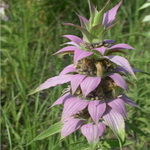| Common Name: |
Horsemint |
| Other Names: |
Dotted monarda, Spotted Monarda |
| Botanical Name: |
Monarda punctata |
| Genus: |
Monarda |
| Family: |
Lamiaceae |
| Native Location: |
USA |
| Cultivation: |
Rich, moist soil in sun (Monarda didyma); sandy or rocky soil in sun (M. citriodora); light, dry, alkaline soil in sun (M. fistulosa and M. punctata). M. didyma is prone to mildew in dry conditions. |
| Propagation: |
By seed sown in spring or autumn; by division in spring; by softwood cuttings in early summer. |
| Harvest: |
Plants are cut when flowering, and leaves before flowering, and used fresh or dried for infusions. |
| Height: |
30-90cm (12-36in) |
| Width: |
30-45cm (12-18in) |
| Hardiness: |
Z3-9 |
| Parts Used: |
Whole Plant, Leaves |
| Properties: |
A bitter, pungent, diuretic herb with a mint-thyme aroma. It increases perspiration, benefits the digestion, and is rubefacient when applied topically. |
| Medicinal Uses: |
Internally for indigestion, colic, nausea and vomiting, diarrhea, feverish chills, colds, and backache. Externally for neuralgia and rheumatism. |
| Culinary Uses: |
Leaves made into "rignum" tea in South Carolina. |
| Bibliography: |
The Encyclopedia of Herbs by Deni Bown Copyright © 1995, 2001 Dorling Kindersley Limited pp.280-281 |
